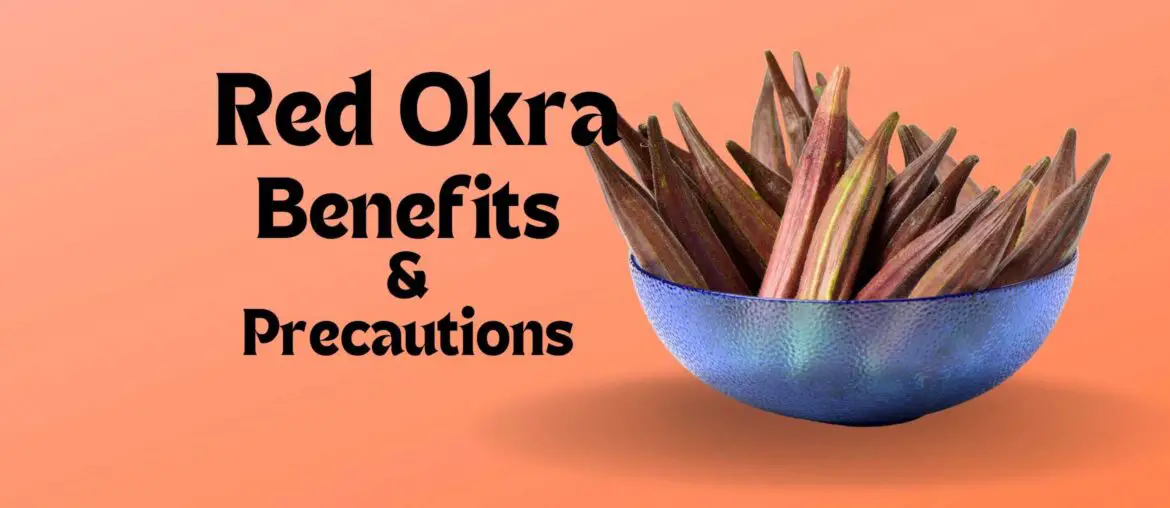Red okra is a variety of okra species with red skin and is an annual herb of the genus okra in the Malvaceae family. The flowers and seeds of red okra can be used as medicine, which has a good curative effect on gastritis, gastric ulcer, and other diseases. It also protects the liver. Capsules are oblong, apex pointed, cross-section pentagonal or hexagonal, and also round. The epidermis has hairs that harden at cooler temperatures.
The efficacy and benefits of red okra

Strengthen the kidney and nourish deficiency
Red okra has the functions of enhancing physical endurance, anti-fatigue, and strengthening the kidneys. Many countries use it to remedy men’s impotence and as a “drug” for the elderly to strengthen the kidney and tonify deficiency. For young adults and athletes, okra can eliminate fatigue and quickly restore physical strength.
Supplements protein
The amount of protein, minerals, and vitamins contained in red okra is higher than that of ordinary vegetables. Therefore, eating more red okra is beneficial to supplement the protein necessary for the human body.
Develops physical strength
Red okra is a vegetable suitable for all ages. Eating more red okra for the elderly helps keep them healthy, while young people eat more red okra to recover their physical strength quickly. For children, eating more red okra helps the body’s development.
Coffee substitutes
The red okra seeds can be used as a substitute for coffee after being roasted and ground.
Protect and nourish the stomach
Red okra is rich in pectin, galactan, and other substances, which help to help digestion in the stomach, promote the absorption of food nutrients and have a positive significance for the treatment of gastric diseases such as gastritis and gastric ulcer.
Use as medicine
The flowers, seeds, and roots of red okra can be used as medicine, and it has a curative effect on malignant sores and carbuncles.
Nutritional value of red okra
Red okra has high nutritional and health value, and all parts contain hemicellulose, cellulose, and lignin. Tender pods are rich in protein, free amino acids, vitamin A, vitamin C, vitamin E, phosphorus, iron, potassium, calcium, zinc, manganese, and other mineral elements and viscous substances composed of pectin and polysaccharides.
In addition, red okra is low-fat and low-sugar and can be used as diet food. Because its trace elements, such as zinc and selenium, can enhance the body’s anti-cancer capabilities. It is rich in vitamin C, can prevent cardiovascular diseases, and improve immunity.
In addition, the combination of rich vitamin C and soluble fiber (pectin) has a mild protective effect on the skin and can replace some chemical skincare products. Soluble fiber can also promote the excretion of organic substances in the body and reduce the collection of toxins in the body.

How to eat red okra
Red okra can be fried, boiled, and salad. Slices can be fried in cornmeal, sprinkled with bread crumbles, or fried in the batter for great flavor. You can also use its sticky juice to make sauces with tomatoes or pickled.
Its young leaves can also be cooked as green leafy vegetables. However, because the leaves are hairy, it is advisable to blanch them in boiling water before frying them. You can use its flowers and buds for cooking soup with a unique flavor, but the flowers are tender and should not be boiled for a long time.
Mature okra seeds are rich in various minerals. They can be eaten as dry beans, processed and ground to make high-protein powder, or roasted and then ground into powder as a substitute or additive for coffee. In addition, you can extract oils and fats.
Can red okra be eaten raw
Red okra can be eaten raw. Red okra is a kind of okra that is rare in color. Many people don’t know how to eat red okra. In terms of nutritional value, red okra is better eaten raw.

Benefits of red okra when eating raw
Resist aging
Red okra is rich in anthocyanins. Anthocyanins are flavonoids. Regular consumption can remove free radicals in the body. Dismutase has a strong antioxidant effect. Regular consumption by beauty-loving women in summer can help anti-aging skin.
Refreshing kidneys
Red okra is rich in vitamins and anthocyanins, which can help the body scavenge free radicals, resist oxidation, reduce cell damage,
enhance physical fitness, and have an excellent nourishing effect on the liver and kidney. Effect.
Prevent constipation
Red okra is a vegetable food that contains a lot of cellulose. Regular consumption can promote gastrointestinal motility and the absorption of nutrients in the stomach, reduce intestinal waste, prevent constipation, and help lose weight.
The difference between red okra and green okra
| Differences | Red okra | Green okra |
|---|---|---|
| Different colors | Red okra is purple-red in the budding period, and the pod it receives is also purple-red, which is also the origin of the name red okra. | Green okra is a common variety of okra, and green okra accounts for a large proportion of the market. |
| Different nutrition | Red okra is high in antioxidants, mainly anthocyanins. | Although green okra is also rich in nutrients, it does not contain anthocyanins. |
| Different eating method | Red okra is mainly eaten raw and cold to ensure the absorption and utilization of anthocyanins. | Green okra is mainly eaten cooked, supplements protein and other minerals, and enhances immunity. |
| Different effects | Red okra is mainly eaten raw to absorb more antioxidants and enhance one’s immunity. | Green okra has a high stimulant effect. After blanching, it will remove many oxalic acids, the cold will be relatively weak, and the health care effect is high. |
| Different prices | The price of red okra is relatively higher than that of green okra, but it is not a lot. | Okra was similar to other ordinary vegetables, a few dollars per pound. |

Can pregnant women eat red okra
Pregnant women can eat red okra. There is not much difference in nutrients between red okra and green okra, but red okra contains more anthocyanins, so it appears red, while other substances are not much different from green okra. Pregnant women can eat it.
Can pregnant women eat red okra raw
Pregnant women can eat red okra raw, but they should not eat more. This is because red okra contains a certain amount of anthocyanins. Anthocyanins are unstable to high temperatures and will be destroyed when the temperature exceeds 70 degrees.
Therefore, red okra is mainly eaten raw. Raw food will consume a large amount of oxalic acid. Therefore, pregnant women need additional calcium supplementation. Overeating raw red okra will cause calcium deficiency in pregnant mothers.
Precautions for pregnant women to eat red okra
- Red okra contains more anthocyanins. This nutrient has a very high tonic effect on pregnant women. Therefore, it is best for pregnant women to eat red okra raw, but the amount should be moderate.
- Red okra also contains mucin and other allergenic ingredients. Therefore, women with allergies are not suitable for eating okra, so
as not to cause allergies, and it is not suitable for the normal development of the fetus and the health of the mother. - Okra is cold food. Therefore, pregnant women should not eat more to avoid diseases.

How often to eat red okra
Red okra is cold food. Therefore, it is not recommended to eat it every day. It is enough to eat red okra once a week. If you eat red okra often, you will have a poor stomach, cold body, gastrointestinal discomfort, and diarrhea in menstrual women.
Precations of eating red okra
Like okra, red okra has a layer of fine wool on the epidermis. The fine velvet of okra is inedible. After entering the intestines will damage the spleen and stomach, causing gastrointestinal discomfort. People with allergies are also at risk of allergies.
Red okra is cold food. Therefore, if people with diabetes have poor physical fitness or suffer from spleen and stomach diseases at the same time, they should not eat more red okra so as not to damage the spleen and stomach.







